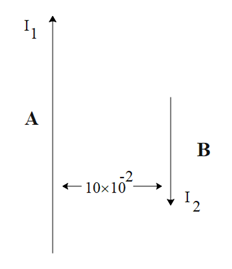
Through two parallel wires A and B, 10A and 2A of currents are passed respectively in opposite directions. If the wire A is infinitely long and the length of the wire B is 2m, then force on the conductor B, which is situated at 10cm distance from A, will be
A. $8 \times {10^{ - 7}}N$
B. $8 \times {10^{ - 5}}N$
C. $4 \times {10^{ - 7}}N$
D. $8 \times {10^{ - 5}}N$
Answer
558k+ views
Hint: The force between two long straight and parallel conductors separated by a distance ‘r’ is found by applying ampere’s circuital law. Ampere’s circuital law states that the line integral of the magnetic field surrounding a closed loop is equal to the number of times of the algebraic sum of the currents passing through the loop.
Formula used:
$F = \dfrac{{{\mu _ \circ }}}{{4\pi }}\dfrac{{2{I_1}{I_2}}}{r} \times l$
Complete answer:
Let us assume two wires carrying current ‘${I_1}$’ and ‘${I_2}$’ and the field produced by the first wire and the force exerted on the second wire known as force ‘${F_2}$’.
Now, the field due to ‘${I_1}$’ at a distance ‘r’ is given as,
${B_1} = \dfrac{{{\mu _ \circ }{I_1}}}{{2\pi r}}$
This resulted field is uniform along the second wire and perpendicular to it, so the force ‘${F_2}$’ exerted on second wire is given as,
$F = IB\sin \theta $
$ \Rightarrow {F_2} = {I_2}l{B_1}$ ; $\sin \theta = 1$
So, by Newton’s third law the forces on the wires are equal in magnitude. We can write ‘F’ for the magnitude ‘${F_2}$’.
The force between two parallel currents ‘${I_1}$’ and ‘${I_2}$’, is separated by a distance ‘r’, has a magnitude per unit length which is given by
$\dfrac{F}{l} = \dfrac{{{\mu _ \circ }{I_1}{I_2}}}{{2\pi r}}$
According to this, the force is said to be attractive when the currents are in the same direction, and is repulsive if they are in the opposite directions.
In order to find the solution of the given question let's draw a rough diagram for a better understanding of the question, and apply the formula of the force between two parallel current carrying wires.

$F = \dfrac{{{\mu _ \circ }}}{{4\pi }}\dfrac{{2{I_1}{I_2}}}{r} \times l$
$ \Rightarrow F = \dfrac{{{{10}^{ - 7}} \times 2 \times 10 \times 2}}{{0.1}} \times 2$
On calculating we get,
$ \Rightarrow F = 8 \times {10^{ - 5}}N$
So, the correct answer is “Option D”.
Note:
We can find the definition of ampere from the above explained concept. One ampere is defined as the current through each of the two parallel conductors of infinite length which is separated by a distance of one meter in a space which is free of other magnetic fields and causes a force of exactly $2 \times {10^{ - 7}}N/m$ on each of the conductors.
Formula used:
$F = \dfrac{{{\mu _ \circ }}}{{4\pi }}\dfrac{{2{I_1}{I_2}}}{r} \times l$
Complete answer:
Let us assume two wires carrying current ‘${I_1}$’ and ‘${I_2}$’ and the field produced by the first wire and the force exerted on the second wire known as force ‘${F_2}$’.
Now, the field due to ‘${I_1}$’ at a distance ‘r’ is given as,
${B_1} = \dfrac{{{\mu _ \circ }{I_1}}}{{2\pi r}}$
This resulted field is uniform along the second wire and perpendicular to it, so the force ‘${F_2}$’ exerted on second wire is given as,
$F = IB\sin \theta $
$ \Rightarrow {F_2} = {I_2}l{B_1}$ ; $\sin \theta = 1$
So, by Newton’s third law the forces on the wires are equal in magnitude. We can write ‘F’ for the magnitude ‘${F_2}$’.
The force between two parallel currents ‘${I_1}$’ and ‘${I_2}$’, is separated by a distance ‘r’, has a magnitude per unit length which is given by
$\dfrac{F}{l} = \dfrac{{{\mu _ \circ }{I_1}{I_2}}}{{2\pi r}}$
According to this, the force is said to be attractive when the currents are in the same direction, and is repulsive if they are in the opposite directions.
In order to find the solution of the given question let's draw a rough diagram for a better understanding of the question, and apply the formula of the force between two parallel current carrying wires.

$F = \dfrac{{{\mu _ \circ }}}{{4\pi }}\dfrac{{2{I_1}{I_2}}}{r} \times l$
$ \Rightarrow F = \dfrac{{{{10}^{ - 7}} \times 2 \times 10 \times 2}}{{0.1}} \times 2$
On calculating we get,
$ \Rightarrow F = 8 \times {10^{ - 5}}N$
So, the correct answer is “Option D”.
Note:
We can find the definition of ampere from the above explained concept. One ampere is defined as the current through each of the two parallel conductors of infinite length which is separated by a distance of one meter in a space which is free of other magnetic fields and causes a force of exactly $2 \times {10^{ - 7}}N/m$ on each of the conductors.
Recently Updated Pages
A man running at a speed 5 ms is viewed in the side class 12 physics CBSE

The number of solutions in x in 02pi for which sqrt class 12 maths CBSE

State and explain Hardy Weinbergs Principle class 12 biology CBSE

Write any two methods of preparation of phenol Give class 12 chemistry CBSE

Which of the following statements is wrong a Amnion class 12 biology CBSE

Differentiate between action potential and resting class 12 biology CBSE

Trending doubts
What are the major means of transport Explain each class 12 social science CBSE

Draw ray diagrams each showing i myopic eye and ii class 12 physics CBSE

Draw a ray diagram of compound microscope when the class 12 physics CBSE

Give simple chemical tests to distinguish between the class 12 chemistry CBSE

Using Huygens wave theory derive Snells law of ref class 12 physics CBSE

Dihybrid cross is made between RRYY yellow round seed class 12 biology CBSE




